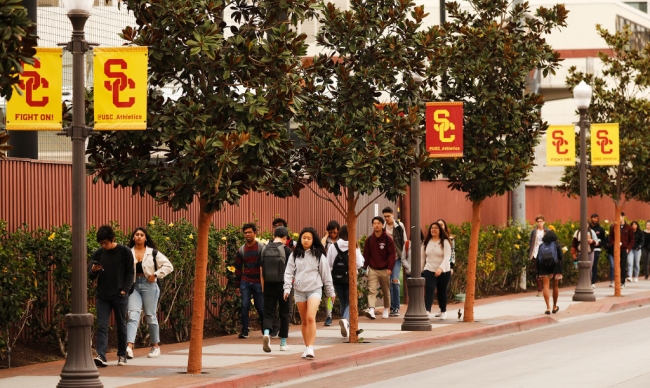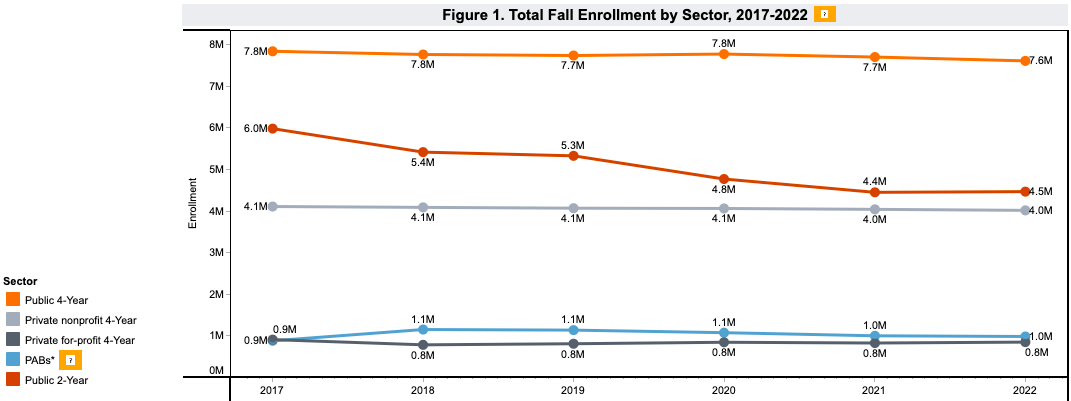You have /5 articles left.
Sign up for a free account or log in.

Freshman enrollment is up for the first time since the pandemic’s onset, even as overall enrollment numbers continue to lag.
Al Seib/Los Angeles Times via Getty Images
After more than two years of declining enrollment numbers, fall 2022 finally brought refreshing news: freshman enrollment, which represented the most significant deficits throughout the pandemic, is up from the previous year, according to the latest data from the National Student Clearinghouse Research Center.
Nearly 2.34 million freshmen enrolled in a college or university last semester, a 4.3 percent increase over fall 2021 and a healthy jump from the 2.24 million who enrolled in fall 2020, soon after the COVID-19 pandemic began.
While the number still remains well below the 2.49 million freshmen who enrolled in 2019, “this is a very promising sign for higher education,” said Doug Shapiro, the research center’s executive director.
Freshman enrollment was up across all higher education sectors, with the greatest growth coming from community colleges, which gained 42,000 first-year students since last fall, an increase of 6.1 percent.
While the number of Latino, Asian and Native American freshmen all increased, the number of Black first-years remained approximately the same as the previous year, while the number of white freshmen declined.

Still, it’s not entirely clear why students are returning to higher education now—or whether the trend is likely to continue into this fall.
“There could be a number of things making this [increase] appear,” said Joni E. Finney, director of the University of Pennsylvania’s Institute for Research on Higher Education. “I think it’s positive, I just don’t think it’s a trend yet. I think we need to see more to know if this is going to stick.”
Finney speculated that one reason freshmen might be enrolling in greater numbers is because many colleges and universities have cut their online course offerings, allowing students to have a more traditional college experience than if they had enrolled two years ago.
Amy Kurfist, a higher education senior research adviser at Hanover Research, a market research firm, said that the shift could also indicate that the recruitment techniques colleges and universities adopted during the pandemic may be working.
“One of the things that we’ve been seeing with our clients is more targeted recruitment,” she said. “It’s less so the colleges just relying on the fact that applications will just come in and they’ll have a class and that will be the end of it.”
‘Stopping the Bleeding’
Although freshman enrollment is on the rise, overall enrollment remained nearly unchanged from fall 2021, declining by 0.6 percent. Some sectors saw marginal increases; enrollment at community colleges, for instance, grew by 0.4 percent—an improvement over the previous two years. In 2020, community college enrollment dropped a whopping 10.5 percent, and in 2021, it decreased by 6.7 percent.
Notably, a significant portion of the community college enrollment increase came from dually enrolled high school students, according to Shapiro; with secondary students removed from the data, community colleges would have experienced yet another dip of between 1.5 and 2 percent.
“In the context of the health of the institutions, those dual enrollments do make a difference,” Shapiro said.

Finney argued that the community college data obfuscate one of the key challenges those institutions face, which is not getting students into seats but rather figuring out how to serve underrepresented populations.
“I don’t think it’s reaching the lower-income and minority students, students who are working jobs while trying to go to school,” she said. “At best, you can say it’s stabilized. I don’t think—there’s no indication in the data they’ve presented, anyway—that community colleges are recovering. Maybe we’re stopping the bleeding, but we’re not doing much more.”
While most sectors saw only minute declines, public four-year institutions lost about 88,000 students, a decrease of 1.4 percent since last year and the largest drop of any sector. Enrollment at private nonprofit institutions dipped 0.6 percent, while for-profit enrollment grew 2.6 percent.
Graduate student enrollment, which boomed during the pandemic, decreased for the first time since 2017, declining 1.2 percent after growing 3 percent in 2020 and 2.4 percent in 2021. Experts noted that the drop might signify an end of the pandemic trend of applying to graduate school in the face of a tight job market, which some attributed in part to the flexibility that many graduate programs offered students.
Geographically, the Northeast and Midwest fared worse than the rest of the country, continuing to experience drops in enrollment—albeit smaller ones than in 2021—while the West and South experienced small increases of 0.5 percent and 0.2 percent, respectively.
Of the top five majors represented in the report, only business saw increases from last year, while health professions, liberal arts, biological and biomedical sciences, and engineering all continued to drop. Computer science, the sixth most popular major, saw significant growth, increasing by 10.4 percent.
At two-year institutions, the number of students studying computer science increased by 7.2 percent. Those pursuing trades also jumped—7.2 percent for construction, 8 percent for culinary services and 5.4 for mechanics—continuing trends from 2021.




